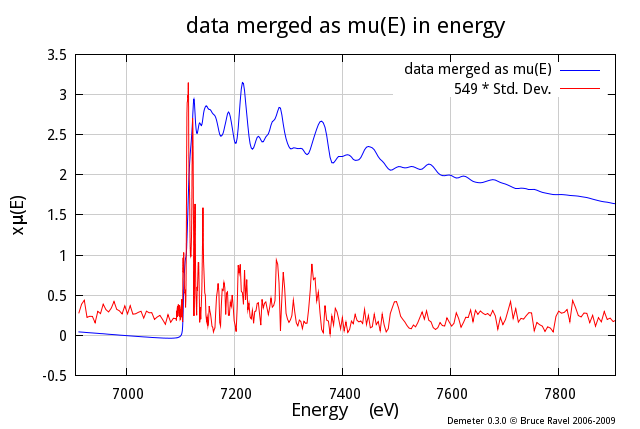Merging data
Merging data is one of the essential data processing steps. As with
every thing, DEMETER tries to make merging as easy as possible:
my $merged = $data[0]->merge('e', @data);
The first argument to the merge method
specifies which spectrum is merged: e
means to merge μ(E), n means to merge
normalized μ(E), and k means to merge
χ(k).
Care is taken not to double count the caller. This is a convenience
because, as shown above, you can pass an entire array which also
contains the caller.
The merge method returns a new Data
object.
Both of the plot types below (stddev and
varience) plot ignore many setting of the
Plot object in order to plot the data in the form in which it was
merged. Attempting to plot the standard deviation or variance plots
with a Data object that does not contain merged data will return as
error.
-
plot merged data with standard deviation
-
- use Demeter;
- my @common = (energy => '$1', numerator => '$2', denominator => '$3', ln => 1,);
- my $prj = Demeter::Data::Prj -> new(file=>'U_DNA.prj');
- my @data = (
- Demeter::Data -> new(file => 'examples/data/fe.060',
- name => "Fe scan 1",
- @common,
- ),
- Demeter::Data -> new(file => 'examples/data/fe.061',
- name => "Fe scan 2",
- @common,
- ),
- Demeter::Data -> new(file => 'examples/data/fe.062',
- name => "Fe scan 3",
- @common,
- ),
- );
- my $merged = $data[0] -> merge('e', @data);
- $merged -> plot('stddev');
|
This shows the merge of μ(E) of 3 iron foil scans along with the
standard deviation array. The standard deviation has been added to
and subtracted from the μ(E) spectrum, so the red trace is an
error margin for the μ(E) spectrum. Note that this plot type can
only be plotted using a Data object which contains the data from a
merge. Trying to plot a non-merged Data object in this way will
return a warning without plotting anything.
 I really need to show noisier data in this example.
I really need to show noisier data in this example.
|

|
-
plot merged data with standard deviation
-
Change line 20 in the script shown above to this:
$merged -> plot('variance');
|
This shows the merge of μ(E) of 3 iron foil scans along with the
standard deviation array. The standard deviation has been scaled to
plot with the μ(E) spectrum, with the scaling factor is given in
the legend. This, then, is a way of visualizing how the standard
deviation is distributed across the spectrum. Note that this plot
type can only be plotted using a Data object which contains the data
from a merge. Trying to plot a non-merged Data object in this way
will return a warning without plotting anything.
|

|
![[Demeter logo]](../../images/Isis-Sothis-Demeter_sm.jpg)
 I really need to show noisier data in this example.
I really need to show noisier data in this example.

